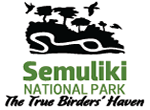[vc_row][vc_column width=”2/3″][vc_column_text]Semuliki National Park is undoubtedly one of the distinct safari parks, founded in 1993 and occupying over 220sq.kms of land area. The park sits on the Western side of Uganda, about 5-6 hours’ drive from Kampala/Entebbe. Semuliki NP protects 441 bird species, 53 species of mammals, 9 diurnal species of primates and more. The park’s diverse birds include among others the shoebill storks, red billed dwarf hornbill, Ross’s turacos, orange weaver, long tailed hawk, crested flycatcher, Congo serpent eagle, red eyed puff back, black casqued wattled hornbill, Maxwell’s black swallow, swamp palm bulbul, leaf love, red bellied malimbe, lemon bellied crombec, red billed helmet shrike, lyre tailed honeyguide.
Wildlife of Semuliki NP include hippos, buffaloes, Uganda Kobs, African civet, crocodiles, Mona monkeys, lions, chimpanzees, waterbucks, bush babies, blue monkeys, black and white colobus monkeys. Others include vervet monkeys, pygmy squirrel, pygmy antelope, red duikers, blue duikers, flying squirrel.
Semuliki National Park sits within Uganda’s equatorial belt, a positioning that dictates both its beauty and its challenges.
The park receives consistent rainfall, averaging 1,250 to 1,500 millimetres per year, with daytime temperatures ranging from 18 to 30 degrees Celsius.
These climatic characteristics influence accessibility, wildlife movement, and visitor comfort more than any other factor.
When is the Best Time to Visit Semuliki?
The best time to go visit Semuliki National Park: Semuliki National Park Uganda is all year-round travel destination. Regardless of this fact, most Uganda safari activities in Semuliki National Park are best carried out during the dry season. The 2 dry seasons in Semuliki NP run from December, January to February and June, July, August to early September.
From June to September, Semuliki National Park is kept drier and temperatures rise from 25 degrees Celsius. However, during these months, afternoon thunderstorms can occur at any time. January to February are hot dry months and they are considered to be good months of the year to go tour Semuliki National Park.
Rainy/Wet season: From October, November to December & March, April to May rains occur at any time. These are also months of the year when routes in Semuliki National Park become muddy and can be challenging to navigate through. During this period, a 4×4 tourist vehicle is the best to use.
Dry Seasons: December to February and June to September
These months define the optimal safari window. Roads between Fort Portal and Bundibugyo remain firm, allowing uninterrupted access to Sempaya Gate and other activity points.
Game drives through the Toro–Semliki Wildlife Reserve become particularly rewarding as animals concentrate near permanent water sources.
For photographers and guided walkers, the air clarity and balanced humidity create favourable light and comfortable trail conditions.
Wet Seasons: March to May and October to November
Rainfall during these months sustains the rainforest canopy that distinguishes Semuliki.
While travel requires patience, the rewards are evident to those who value ecological observation.
Birding specialists often favour these months, citing heightened vocal activity and nesting displays from Central African species such as the Nkulengu rail and Congo serpent eagle.
Vegetation growth peaks, and the forest’s microclimate takes on its most active state.[/vc_column_text][/vc_column][vc_column width=”1/3″][vc_widget_sidebar sidebar_id=”shop-widget”][/vc_column][/vc_row]
